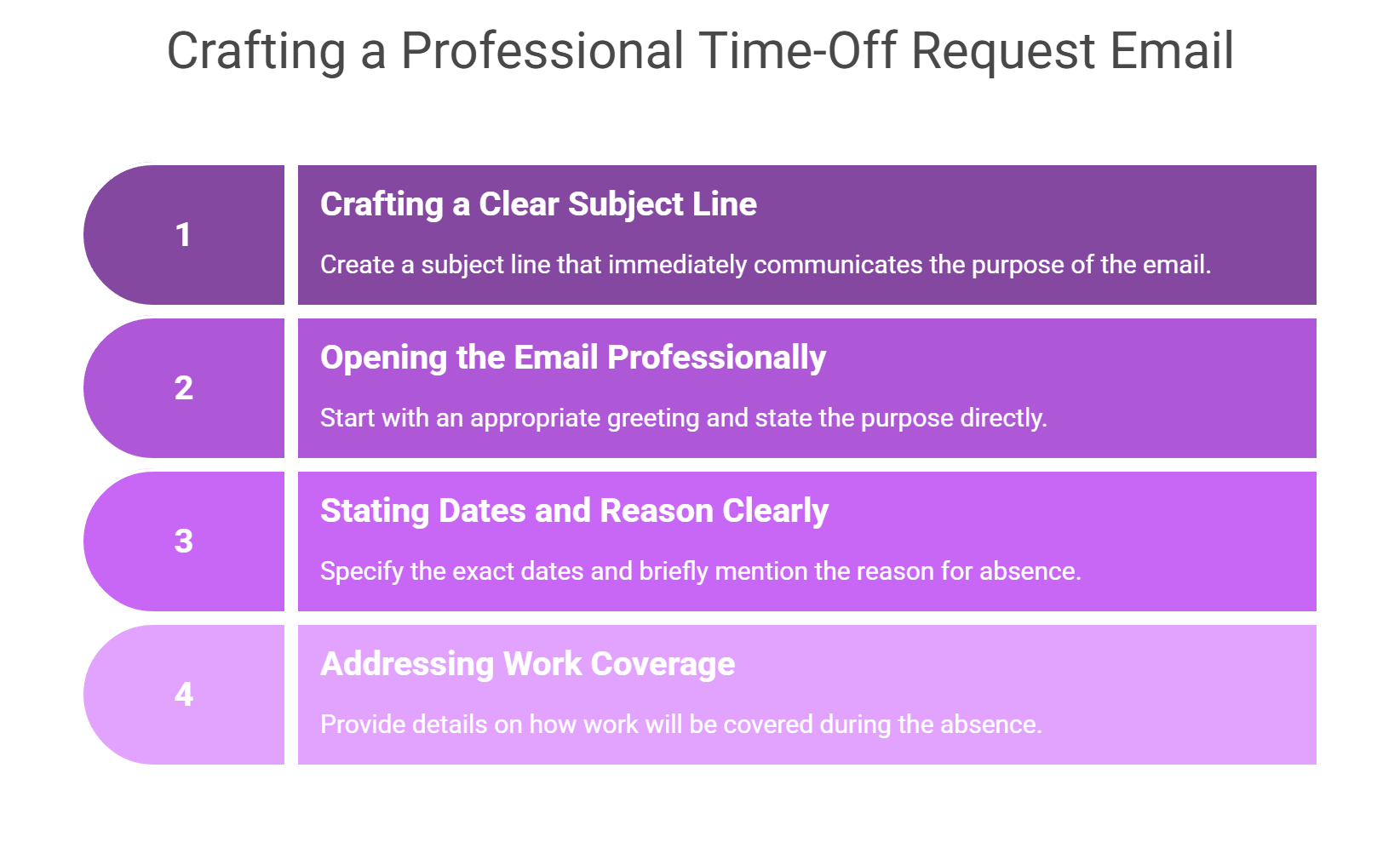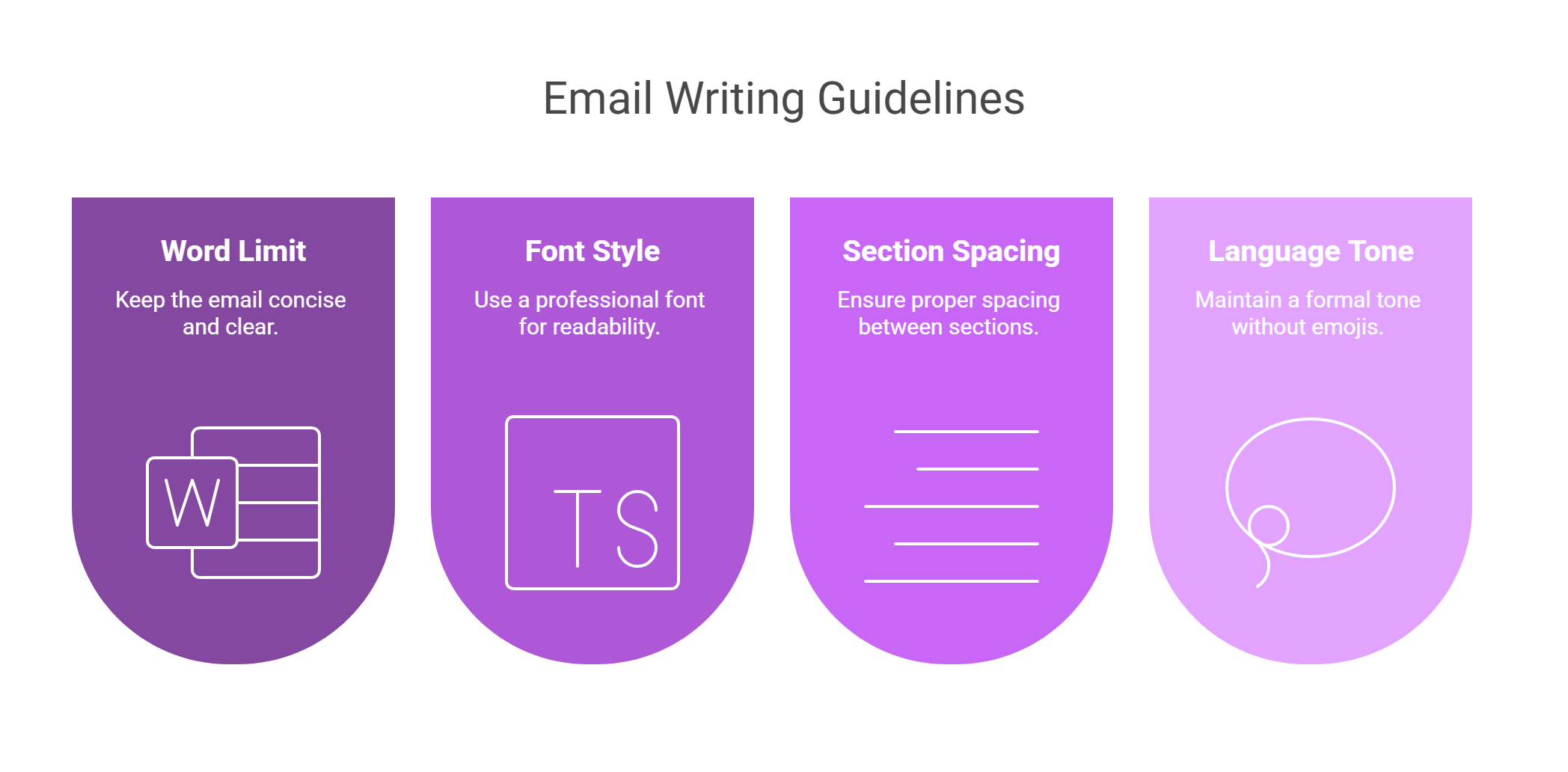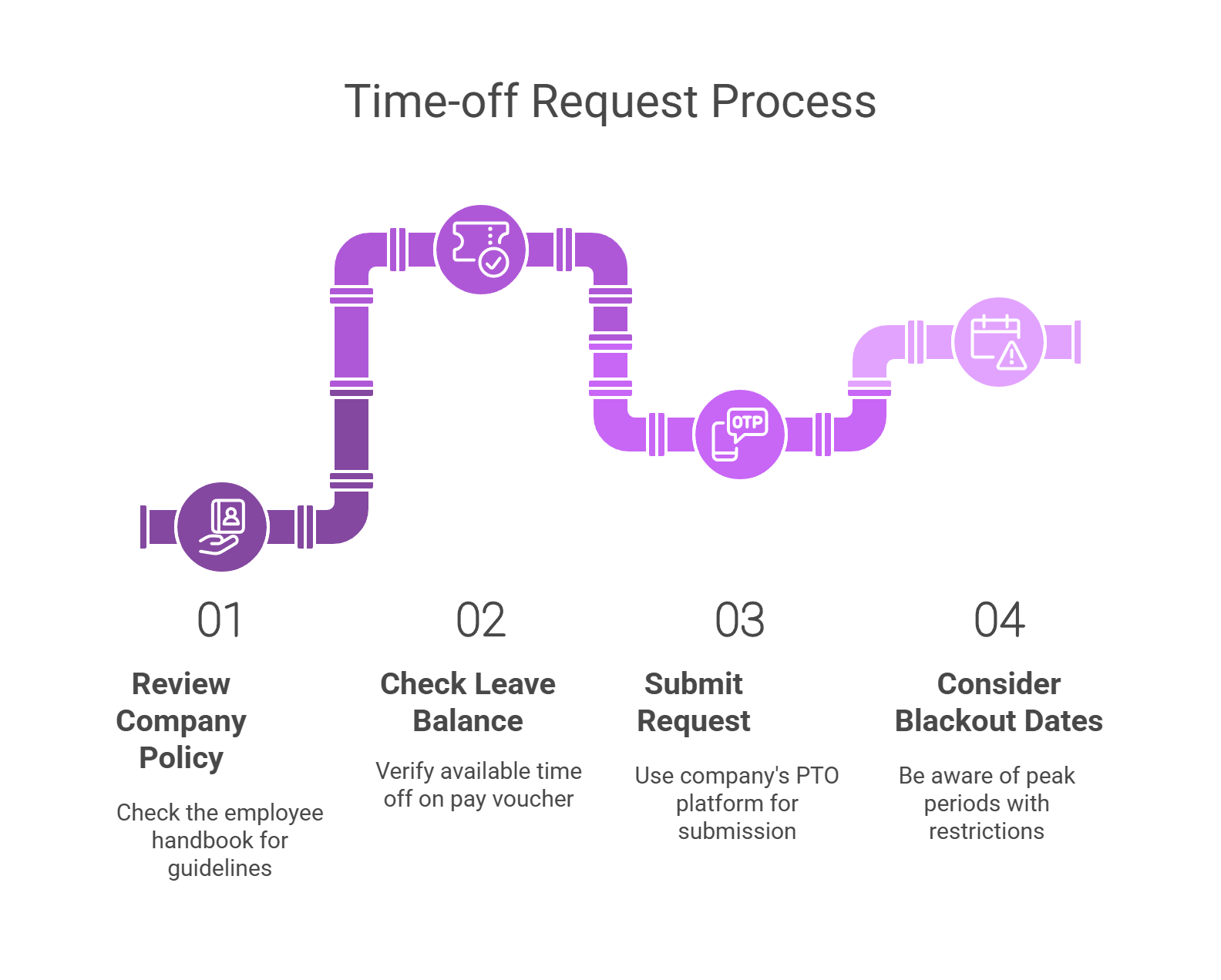The average U.S. employee in the private industry sector receives 10 to 14 days of paid vacation annually, and many don’t use all of them.
Yet, taking time off is crucial for well-being and productivity. If you need help writing a PTO request email, you'll find several templates in this article, as well as useful tips.
Writing Your Time-off Request Email
A well-crafted time off request email demands attention to detail and proper formatting.
Here's exactly what makes a time-off request email effective.

Crafting a clear subject line
Your subject line creates the first impression and must immediately communicate your request's purpose.
Direct and specific subject lines help managers quickly understand what they're opening.
Here are two strong examples:
"Request for Time Off – [Your Name]"
"Vacation Request – [Your Name]".
When your request requires immediate attention, add "Urgent" or "Immediate Attention Required" to highlight its importance.
Clear subject lines ensure your email receives timely attention and make it easier for your manager to reference later when approving or tracking team absences.
Opening your email professionally
Start with an appropriate greeting that addresses your supervisor by name.
A simple "Good morning" or "Hello [Manager's name]" establishes a professional yet approachable tone.
Follow your greeting with a straightforward statement about the purpose of your email.
Directly state that you're requesting time off rather than burying your request in unnecessary context.
This directness shows respect for your manager's time and clearly establishes what you need.
The professional tone throughout your message demonstrates your commitment to workplace etiquette.
Stating your dates and reason clearly
Specify the exact dates you need off at the beginning of your email body.
Include both weekdays and calendar dates to eliminate any confusion.
For instance:
"I'm writing to request time off from Monday, June one to Tuesday, June 14 for a planned family vacation".
A brief mention of your reason for absence serves as a professional courtesy without oversharing personal details.
Simply note whether you're planning a vacation, handling personal matters or scheduling medical appointments.
Mentioning your advance notice shows consideration for team planning and scheduling needs.
Addressing work coverage during your absence
Proactive work coverage plans demonstrate responsibility and team consideration.
Your manager's primary concern is usually how work will continue while you're away.
Address this directly by mentioning colleague coverage arrangements or project completion plans.
Specific statements work best:
"My current project will be completed before I leave on Friday" or "I've arranged with Sarah to handle client calls during my absence."
This information reassures your manager that operations will continue smoothly.
Adding whether you'll be reachable for true emergencies gives additional peace of mind that critical issues won't be left hanging.

Formatting Tips
- Keep the email under 150 words.
- Use a professional font like Arial or Calibri, size 11–12.
- Leave space between sections for readability.
- Avoid emojis and overly casual language.
Sample time-off request email
Subject: Vacation Request – Jane Doe – July 10–14
Hello [Manager's Name],
I’m writing to request vacation leave from Monday, July 10 to Friday, July 14.
I’ve coordinated with Alex to manage all active client communications in my absence and will ensure my current tasks are completed before I leave.
Please let me know if you need anything else from me.
Thank you for your time,
Jane
Time-off Request Email Templates
Ready-to-use templates save you valuable time and ensure you include all necessary details when requesting time off.
Good templates function as frameworks you can quickly customize to match your specific situation and company culture. Here are a few samples:
Vacation request template
Start with a direct subject line like "Vacation Request – [Your Name] – [Dates]" that immediately communicates your purpose.
Subject: Vacation Request – John Smith – July 10 to July 21
Hi [Manager's Name],
I hope you're well. I am writing to request vacation time from Wednesday, July 10 through Sunday, July 21.
I'm planning a family vacation and wanted to provide this advance notice to assist with scheduling and workload planning.
I’ve already briefed Alex on my current projects and have included him in all relevant client communications over the past week to ensure a smooth transition during my absence.
Thank you for considering my request. Please let me know if you need any additional information.
Best,
John
End with a simple appreciation, such as: "Thank you for considering my request".
Personal day request template
Personal day requests should be concise while covering all essential points.
Subject: Personal Day Request – Jane Lee – March 15
Hi [Manager's Name],
I’d like to request a personal day off on Friday, March 15.
All urgent tasks have been completed in advance, and I’ve informed my team of my brief absence. They’ll cover any immediate needs while I’m out to ensure there’s no disruption to our workflow.
Please let me know if you have any concerns. Thanks for your understanding.
Best,
Jane
Personal day requests typically need less advance notice than vacations, but company policies vary widely on this point.
Check your organization's specific guidelines before submitting.
Medical leave request template
Medical leave requires additional sensitivity and sometimes formal documentation.
Subject: Medical Leave Request – Michael Rivera
Hi [Manager's Name],
I’m writing to formally request medical leave from Monday, April 22 to Friday, May 3.
While I don’t anticipate being available during this time, I will check email once daily for any truly urgent matters that only I can address.
I’ve prepared a detailed handover document and coordinated with Jamie to take over my responsibilities during my absence.
Thank you for your support and understanding.
Sincerely,
Michael
Include only necessary medical information — specific diagnoses aren't required unless your company policy specifically asks for them.
Understanding Time-off Request Basics
Before writing any time off request, knowing the fundamentals helps prevent complications and increases your approval chances.
Most denied requests stem from overlooking company policies or submitting incomplete information.
Taking a few minutes to understand your company's specific requirements saves you from potential headaches later.

Company policies you should know first
Start by reviewing your organization's time off request policy, typically found in the employee handbook.
This document outlines the specific guidelines for requesting absences and details exactly how many days of paid or unpaid time off you're eligible to request.
Most companies require documentation through specific channels, such as leave request forms or self-service portals.
Pay close attention to advance notice timeframes — many organizations require foreseeable leave requests at least two weeks before your intended start date.
If your company uses a PTO platform like BambooHR, Day Off or Workday, be sure to complete the formal submission after emailing your manager.
Check your current leave balance by looking at your most recent pay voucher or employee portal before submitting any request.
This small step prevents the embarrassment of requesting more time than you have available.
Many companies also establish "blackout dates" during peak business periods when time off requests face stricter scrutiny or outright denial.
Different types of time off to request
Time off categories serve different purposes, each with its own approval procedures:
- Vacation time lets you take planned breaks for travel, relaxation or personal obligations.
- Sick time ensures you don't work while ill or injured.
- Personal days offer flexibility for appointments, events or obligations that don't fit neatly into other categories.

Specific situations qualify for specialized leave types.
- Bereavement leave supports employees experiencing the death of a family member.
- Jury duty leave receives legal protection in most states.
- Family and medical leave provides extended time for health issues, often with FMLA protection for eligible employees.
Who to send your request to
Your immediate supervisor typically reviews and approves time off requests.
This person must verify your available leave balance before approving any paid time off.
Some companies use an approval chain where both your direct manager and department head must approve requests.
Larger organizations often involve HR departments in tracking and documenting all leave.
Once submitted, your supervisor must respond to your request with either approval or a written explanation for denial.
Understanding this approval process before submitting lets you direct your request properly and follow up appropriately if you don't receive a timely response.
Following Up on Your Request
After sending your time off request email, waiting passively for a response can cause unnecessary stress.
Even excellent managers occasionally miss emails during busy periods, particularly when handling multiple time off requests from different team members.
When to send a reminder
A well-timed reminder demonstrates professionalism without appearing pushy.
Wait at least three days after your initial request before sending your first follow-up.
This gives your manager reasonable time to review your request alongside their other responsibilities.
For standard requests, follow a structured reminder schedule:
- Send your first follow-up if you haven't heard back within five days.
- Send a final reminder two days before any crucial planning deadline.
This gradual approach shows respect for your manager's schedule while ensuring your request doesn't slip through the cracks.
Keep your reminder brief and reference your original email specifically.
"Hello Sarah, I'm following up on my vacation request for July 10–17 that I submitted last Thursday. Please let me know if you need any additional information from me before approving".
This approach is professional and solution-oriented rather than demanding.
How to handle a delayed response
When your time off date approaches without approval, a quick phone conversation often resolves the situation faster than additional emails.
This direct approach shows initiative and often gets immediate results. Keep your tone friendly and collaborative during this conversation.
After your call, document your discussion with a brief email:
"Hi Mark, thanks for our conversation today about my pending vacation request for next month".
This creates a record of the interaction and confirms any verbal agreements.
If these efforts still don't produce a response and your leave date is getting close, you may need to escalate the situation.
Before taking this step, ensure you've given your direct manager ample opportunity to respond.
When escalating, forward your previous communications along with a concise note explaining why you need a timely decision.
Most approval delays result from oversight rather than deliberate avoidance, so maintain a constructive approach throughout the process.
Final Tips for Successful Time-off Requests
Requesting time off should be simple—not stressful. The most effective requests are clear, direct and considerate of your team.
State your dates plainly, share your coverage plan and follow up if needed. Always check your company’s policies before submitting.
Taking your earned time off boosts both your well-being and your performance. Don’t let your vacation days go to waste — just ask the right way.
With the templates and tips above, you’re ready to submit your request confidently and focus on what matters most: enjoying your time away.










Loading comments...